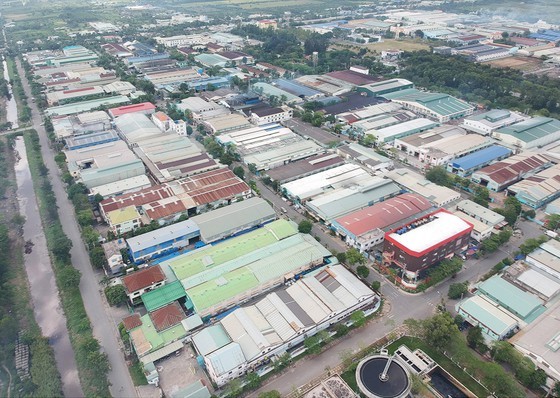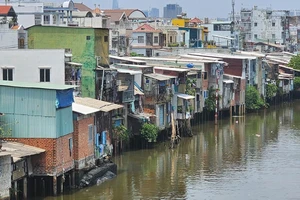
The reason is that the infrastructure of export processing zones and industrial parks is not able to meet the current investment situation of enterprises in general and foreign-invested enterprises in particular.
According to Mr. Dao Xuan Duc, deputy head of the Ho Chi Minh City Export Processing and Industrial Zones Authority (HEPZA), the city currently has three export processing zones and 16 industrial parks with total area of 4,532 hectares. Of which, 17 export processing and industrial zones with more than 1,200 projects having been put into operation attracted more than 290,000 workers.
By the end of last year, accumulated export turnover of export processing and industrial zones reached $66.41 billion, accounting for 15 percent of the city’s export turnover. Goods produced in export processing and industrial zones were exported to more than 45 countries in the world. Of which, Japan’s market accounted for 42.11 percent, followed by the EU market with 16.27 percent and the US market with 15.44 percent. At the same time, new markets, including countries South America, Africa, Northeast Asia and the ASEAN have been opened, helping Vietnamese products to enter more and more deeply into global market. Amid the current economic situation, several enterprises in export processing and industrial zones have shifted business direction to participating in global supply chains for large economic groups.
However, after developing rapidly, investment attraction at export processing and industrial zones in the city has encountered many shortcomings.
According to Mr. Duc, advantages in investment attraction of the city in general and of export processing and industrial zones in particular have weakened in comparison with some neighboring cities and provinces.
Particularly, land rental rates in the city are fairly high while infrastructure fails to meet diverse demand of investors. Current average land rental at export processing and industrial zones in the city is kept at $125 per square meter per lease term of 40-50 years. Meanwhile, average land rental of Dong Nai Province is $74 per square meter per lease term of 40-50 years; of Binh Duong is $43.7 per square meter per lease term of 40-50 years; and of Long An Province is $76 per square meter per lease term of 40-50 years.
On the other hand, occupancy ratio of export processing and industrial zones in the city is always higher than that of neighboring provinces. However, it is not divided by zone but established sparsely, raising difficulties for existing enterprises who want to expand investment. As for new enterprises, if they need a large area for investment, there is not enough area to arrange for them. In addition, amid the context of the development of the 4th industrial revolution, input factors including cheap labor cost and plentiful natural resources are no longer the advantages of the city, leading to a decline in industrial growth rate of the city.
It is forecast that by the end of this year, total value of investment capital to export processing and industrial zones of the city will exceed $12.4 billion. Of which, foreign sector will be $6.8 billion and domestic sector will be $5.6 billion, much lower than those of neighboring provinces.
Amid the current situation, Mr. Nguyen Phuong Dong, deputy director of the Department of Industry and Trade of Ho Chi Minh City, suggested restructuring and converting new model for export processing and industrial zones in order to attract investment intensively, develop sustainably and integrate into global economy.
According to review of HEPZA, many labor-intensive enterprises in export processing and industrial zones which operated inefficiently and caused environmental pollution have transferred their factories to infrastructure development enterprises and other enterprises and projects that operate more effectively.
For instance, Linh Trung Export Processing Zone has successfully converted seven old projects of manufacturing industries, such as writing pens, wooden interior furniture, hats and plastic packing with total investment capital of $34.5 million, into new projects, including machine-processed precision part manufacturing which is used in industrial machinery, automation system and robot manufacturing; electrical cables used in robots, industrial machinery and medical devices; manufacturing and assembling high-end electronic products and audiovisual equipment with total investment capital of $193 million.
Or in Tan Tao and Le Minh Xuan industrial parks, 18 enterprises with inefficient operation have transferred their land and factories to other enterprises for them to establish new projects of industries encouraged by the city. Among these 18 new projects, three are foreign invested and 15 are domestically-invested with total investment of more than VND2.54 trillion.
Representative of Tan Thuan Limited Company said that restructuring export processing and industrial zones is necessary. However, authorities should have a clear direction, limit labor-intensive industries, prioritize investment in high-tech industries with labor productivity and knowledge content.
As for infrastructure development investors of export processing and industrial zones should also take into account development of service infrastructure for enterprises, accommodations for experts and workers. More importantly, they must become a bridge that connect enterprises, enable enterprises to invest and increase competiveness to meet domestic market and export, then step by step participate in global supply chains.
























